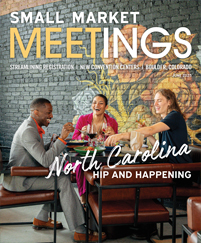
All photos courtesy the Capital Hotel
Considered the most Southern of America’s literary magazines, the Oxford American chose a venue that was its equal in terms of Southern sensibility when it held its first-ever fundraiser two years ago.
Publisher Warwick Sabin picked the Capital Hotel — small in size, large in stature — located in the magazine’s hometown of Little Rock, Ark.
There, in the shadow of the modern Peabody Little Rock, sits the historic 94-room hostelry, in operation for most of the past 135 years.
Sabin was in search of a venue that lacked pretension but exuded graciousness.
“People have high expectations of what they will experience at an Oxford American event,” said Sabin. “This couldn’t be a cookie-cutter event. We didn’t want a convention-center setting with the same old food and live auctions.
“We wanted something very different. That meant having it in a place that intimately connected with the best of Southern culture. And so, in our hometown of Little Rock, the Capital Hotel stood out as my first choice. The hotel itself is directed toward showcasing the best of Southern culture, so it aligns well with Oxford American.”
Capital caught eyes
When it reopened five years ago after a two-year renovation and restoration, the Capital caught many eyes. Little Rock leaders Warren and Harriet Stephens orchestrated the $26 million project after buying other family members’ interest in the hotel.
Warren Stephens is the CEO of Little Rock-based Stephens, a financial services firm best known for taking its fellow Arkansas company Walmart public.
The Stephenses cut no corners; the result is a hotel that impresses those who’ve stayed in the finest, such as Sherrise Stephens, who calls herself a “hotel snob.”
Now manager of global accounts for Helms Briscoe and previously with the Little Rock Convention and Visitors Bureau, Sherrise Stephens places the Capital in a class with the Palace in New York.
“It is a historic hotel, but there is not one thing that is worn in the whole building,” said Stephens. “It is not resting on its laurels.”
The Capital’s director of marketing, Chuck Magill, credits painstaking rehabilitation of what had become a tired property. “This hotel was restored with the most astonishing eye to detail you could imagine.”
Rooms reworked
Guest rooms were reworked, giving the hotel fewer rooms but better configurations. Among the three tiers of room types are one- and two-bedroom suites.
Kitchens were added everywhere, or so it seems. The hotel has five; one for each of two ballroom areas; one for its fine dining restaurant, Ashley’s; one for the Capital Bar and Grill; and one for its catering operation.
“No single ballroom goes without its own kitchen, so there are no hot boxes rolling from one to another,” said Sherrise Stephens.
Suited for small meetings
More than 6,000 square feet of meeting space was also created within the hotel’s walls.
At the front of the hotel, flanking its second-floor mezzanine, are two parlors, each about 1,500 square feet in size. Jutting from the front of the hotel, accessed from the mezzanine, is a wide, glass-roofed balcony, large enough for several clumps of wicker couches and chairs, cooled by old-fashioned fans on pedestals. From the perch, guests can see the streetcars below and watch the comings and goings at the Statehouse Convention Center across the street.
Downstairs on the main level and at the rear of the lobby is the hotel’s largest meeting space, its 1,850-square-foot ballroom. White lattice walls give the impression of a Victorian arbor. Down another hallway off the lobby are the hotel’s other two meeting rooms, about 1,100 square feet total.
The parlors and the main ballroom work well for the configuration Magill says is most popular for small, executive meetings — the hollow square for 50 attendees. “All three of the hotel’s primary rooms can be set in a hollow square.”












